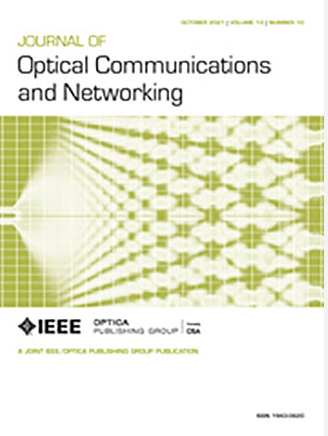Upstream receiver IQ impairment analysis and compensation in coherent digital subcarrier multiplexing passive optical networks
IF 4.3
2区 计算机科学
Q1 COMPUTER SCIENCE, HARDWARE & ARCHITECTURE
引用次数: 0
Abstract
The growing demand for high-capacity and flexible access has made digital subcarrier multiplexing (DSCM)-based coherent passive optical networks (PONs) increasingly attractive. However, in upstream transmission, amplitude, phase, and skew mismatches between the in-phase (I) and quadrature (Q) branches at the receiver of the optical line terminal may lead to image interference between symmetric subcarriers, thus degrading the system performance. To address this issue, this work theoretically analyzes the impairment mechanism and proposes a data-aided相干数字副载波复用无源光网络中上游接收机IQ损伤分析与补偿
对高容量和灵活接入的需求日益增长,使得基于数字子载波复用(DSCM)的相干无源光网络(pon)越来越有吸引力。然而,在上行传输中,光线路终端接收端的同相(I)和正交(Q)支路之间的幅度、相位和偏度不匹配可能导致对称子载波之间的图像干扰,从而降低系统性能。为了解决这一问题,本工作从理论上分析了减值机制,并提出了一种数据辅助的8 \ × 4$实值多输入多输出(MIMO)联合补偿均衡方案。据我们所知,这是基于mimo的子载波联合均衡在突发模式上游接收中用于接收机智商损伤补偿的第一个实验演示。实验结果表明,所提出的MIMO对IQ偏差的补偿稳定,补偿幅度可达$\pm {40}\;{\ rm ps} $和智商获得不平衡从$ {-}{8}$ $ {+}{7}\;{\rm dB}$在双副载波系统中,同时在高达500 MHz的频率偏移下保持0.5 dB以内的Q-penalty。进一步演示了400G TFDM-PON上游系统,实现${-}{29.1}\;{\rm dBm}$接收机灵敏度和32.1 dB功率预算。这些结果为减轻IQ损伤提供了一种实用的解决方案,并支持基于相干dscm的接入网络的稳健、可扩展部署。
本文章由计算机程序翻译,如有差异,请以英文原文为准。
求助全文
约1分钟内获得全文
求助全文
来源期刊
CiteScore
9.40
自引率
16.00%
发文量
104
审稿时长
4 months
期刊介绍:
The scope of the Journal includes advances in the state-of-the-art of optical networking science, technology, and engineering. Both theoretical contributions (including new techniques, concepts, analyses, and economic studies) and practical contributions (including optical networking experiments, prototypes, and new applications) are encouraged. Subareas of interest include the architecture and design of optical networks, optical network survivability and security, software-defined optical networking, elastic optical networks, data and control plane advances, network management related innovation, and optical access networks. Enabling technologies and their applications are suitable topics only if the results are shown to directly impact optical networking beyond simple point-to-point networks.

 求助内容:
求助内容: 应助结果提醒方式:
应助结果提醒方式:


